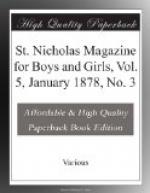AN ILLUMINATED BORDER FOR A PHOTOGRAPH.
St. Nicholas has given us of late such precise directions for the process of illuminating in color,[2] that it is not needful to repeat them; but we should like to suggest an idea to those of you who have begun to practice the art. This is to illuminate a border or “mount” around a favorite photograph. The picture must first be pasted on a large sheet of tinted card-board, pale cream or gray being the best tints to select. You then measure the spaces for your frame, which should be square if the picture is oval or round, and outline them lightly in lead-pencil. Next you sketch and paint your pattern,—flowers, leaves, birds, butterflies, or a set pattern, as you prefer,—putting the designs thickly together; and, lastly, you fill all the blank spaces in with gold paint, leaving the pattern in colors on a gilded ground. The outer edge of the frame should be broken into little scallops or trefoils in gold, and the card-board should be large enough to leave a space of at least three inches between the illuminated border and the frame, which should be a wide band of dull gilding or pale-colored wood, with a tiny line of black to relieve it. The ornament should, if possible, chord in some way with the picture. Thus a photograph of a Madonna might have the annunciation-lilies and passion-flowers on the gold ground.
[Footnote 2: SEE ST. NICHOLAS, Vol. IV., page 379.]
A BOOK OF TEXTS.
Another choice thing which can be done by a skillful illuminator is a small book, containing a few favorite texts, chosen by some friend. Half-a-dozen will be enough. Each text occupies a separate page, and is carefully lettered in red or black, with decorated initials, and a border in colors. A great deal of taste can be shown in the arrangement of these borders, which should be appropriate to the text they surround. A title-page is added, and the book is bound in some quaint way. A cover of parchment or white vellum, illuminated also, can be made very beautiful.
A CARTE-DE-VISITE RECEIVER.
For this you must procure from the tin-man a strip of tin three times as long as it is wide—say six inches by eighteen—with each end shaped to a point, as indicated in the picture. Measure off two bits of card-board of exactly the same size and shape; cover one with silk or muslin for a back, and the other with Java canvas, cloth, or velvet, embroidered with a monogram in the upper point, and a little pattern or motto in the lower. Lay the double coverings one on each side of the tin, and cross the outside one with narrow ribbons, arranged as in the picture. Overhand firmly all around; finish the top with a plaited ribbon and a little bow and loop to hang it by, and the bottom with a bullion fringe of the color of the ribbon.




